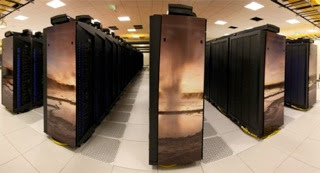 |
| The Colorado River Basin |
The Colorado River Basin is a
magnificent water system that stretches from Wyoming all the way to California.
It touches seven states in the western US, including huge expanses of Colorado,
Utah and Arizona. Almost 30 million people depend on
and use the Basin for water. Headwater states, like Wyoming, Colorado and Utah,
have to ensure that Lower Basin States receive their obligated water allotment,
as described in the 1922 Colorado River Basin Compact. The problem
is, western states are experiencing expanding populations with
increasing demand for urban and agricultural water use. Population expansion in
the Upper Basin States will not only add to the strain on the Basin’s water
resources, it may also strain inter-state relationships as it becomes harder
for them to meet the water obligations to Lower Basin States described in the
Compact. Fortunately for the west, researchers are already looking at these
issues, and they’re doing so with the help of the NSF EPSCoR grant called CI-Water.
The CI-Water grant is a three year
award shared between the University of Wyoming, Brigham Young University, the
University of Utah and Utah State University. Together, the four universities,
among other projects, are working to address and avert the problems looming for
the Colorado River Basin by mapping, modeling and creating the tools to better
understand the Basin. Dr. Fred Ogden and Dr. Craig Douglas of UW are taking the
lead on mapping and modeling the Basin.
 |
| NWSC off of I-80 west of Cheyenne, WY. |
Mapping and modeling require
significant computer power and memory. Most computers however, do not allow for
the resolution and accuracy that Dr. Ogden and Dr. Douglas are looking for in
their models. In order to achieve the scale they’re looking for, they need a supercomputer that can
perform calculations at fast speeds, render data into models and provide a
resolution vastly higher than what is currently available. It just so happens
that Wyoming has such a computer, as of October 15th, 2012.
For seven years, Wyoming and the
National Center for Atmospheric Research (NCAR), with support from the National
Science Foundation, have been planning and working towards building a
supercomputing facility. This month, the years of planning and work came to an
end with the opening of the NCAR-Wyoming Supercomputing Center
(NWSC). The $74 million center houses the $30 million supercomputer,
Yellowstone, which Dr. Ogden and Dr. Craig will use to model the Colorado River
Basin.
Yellowstone is ranked in the top 25 list of fastest
computers on Earth. It can perform 15 quadrillion (that is,
15,000,000,000,000,000) basic calculations per second. This is equivalent to
everyone on the planet conducting 200,000 calculations per second
simultaneously. Yellowstone can also store 11 petabytes of data, which is approximately equal
to the total amount of data stored at the Library of Congress. This
supercomputer opens the doors of opportunity for Wyoming researchers by giving
them a tool that they have not previously had access to. It will put them on
the cutting edge of science, especially regarding the environment.
 |
| Yellowstone, the supercomputer housed at NWSC. |
For Dr. Ogden and Dr. Douglas,
Yellowstone’s ability to synthesize large, varied data sets in a relatively
short amount of time and produce accurate, usable models of the real world
make all the difference in the world for their research. These models will be
more complex and at a resolution 100 times higher
than models produced on regular computers, which means that they will help
inform policies and management decisions with more accuracy than before. The
models produced by Yellowstone will be used by CI-Water to understand how
population changes and water management are impacting the basin, what that
means for the future of water in the west, and how we can begin planning, so
that twenty years from now there is still enough water for everyone. These
models and data will be an important part of the second annual CI-Water
Symposium as the four universities look towards sharing information with
stakeholders and decision makers, so that better plans for the future are
possible.
For more information about water in
the west and UW’s research in this area, visit http://youtu.be/63zWXBKQR5E.
For more information about
Yellowstone, NWSC and a virtual tour, visit http://nwsc.ucar.edu/ and http://nwsc.ucar.edu/facility/visit.
Or, visit http://www.uwyo.edu/uw/news/index.html for more
in-depth stories about the Yellowstone supercomputer, NWSC and UW
researchers.
NWSC also has a visitor center with
hands-on displays and activities, which is open from 8-5 Monday through Friday
and 8-4 on Saturday. The center is located 5 miles west of Cheyenne, WY off of
I-80.
Photos courtesy of http://www.waterencyclopedia.com/Ce-Cr/Colorado-River-Basin.html, the University of Wyoming, UCAR
No comments:
Post a Comment